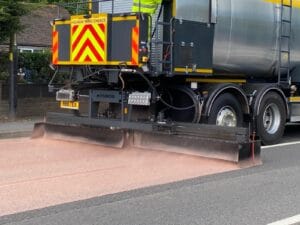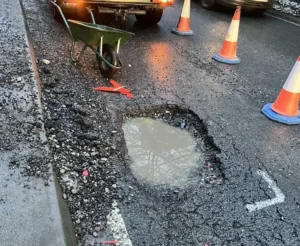More than half of the local road network in England and Wales is reported to have less than 15 years’ structural life left as the amount needed to fix the backlog of carriageway repairs increases to a record high of £16.3 billion.
This year’s Annual Local Authority Road Maintenance (ALARM) survey report, published today (19 March 2024) by the Asphalt Industry Alliance, highlights the scale of the challenge that faces local authority highway teams who have a statutory responsibility to keep local roads safe but don’t have the funds to do so.
Despite local authority highway teams reporting an overall increase in carriageway maintenance budgets, they have been hit by the impact of rising costs due to inflation, meaning they have been able to do less. This has been compounded by the increasing frequency of extreme weather
events, which together are accelerating the rate at which the network is deteriorating.
ALARM data shows that only 47% of roads in England and Wales are classed as being in good structural condition, with the remaining 53% – more than 107,000 miles – now having less than 15 years’ structural life remaining.
Surface conditions are also reported to have declined, despite a 40% increase in the number of potholes filled over the last 12 months adding to he existing patchwork of previous repairs.
This year’s ALARM survey is the 29th and received responses from 72% of local authorities in England and Wales. It reports local road funding and conditions based on information provided directly by those responsible for their maintenance.
The findings, which relate to the 2023/24 financial year, show that in England and Wales:
- Local authorities would have needed an additional £1.22 billion (an average of £7.2 million per authority) just to
reach their own target road conditions. - It would now cost £16.3 billion to tackle the backlog of carriageway repairs and bring the network up to a
standard from which it can be maintained efficiently and cost-effectively going forward. - Less than half (47%) of all local roads are reported to be in good structural condition meaning the remaining
107,000 miles (53%) could continue to deteriorate to the point of needing to be rebuilt within the next 15 years
without appropriate maintenance measures taking place. - £143.5 million has been spent filling in 2 million potholes over the last 12 months.
- Roads are only resurfaced on average once every 80 years.
Rick Green, Chair of the Asphalt Industry Alliance, said: “It’s clear that there is still a mountain to climb when it comes to improving the condition of our local roads, which are a key asset on which we all rely, every day.
“The Government has recognised that fixing our roads is about more than filling in potholes with its announcement of the additional Network North funding in England. But, while the Transport Secretary stated that this additional £8.3 billion over 11 years is enough to resurface 5,000 miles of local roads, this equates to just 2.5% of the network – or less than 0.25% per year.
“Unfortunately, it will do little to address the scale of the issue with ALARM findings reporting that 11% of local roads are already in poor condition and likely to require maintenance in the next 12 months alone.
“That said, English authorities would be in an even worse position without this additional funding, so we sincerely hope that this promise is delivered on and that the Welsh Government honours its commitments to prioritising highway maintenance.
“We need to reach the point where local authority highway engineers are able to plan and proactively carry out maintenance work in the most timely and efficient way to the greatest benefit of all road users – rather than just having enough money to address immediate and urgent repairs.”
The full ALARM survey report will be available to download from 00.01 hours on Tuesday 19 March by visiting www. asphaltuk.org
The Local Government Association said the report shows the huge challenge facing councils in maintaining the local roads network.
Transport spokesperson, councillor Darren Rodwell said: “Only with a long-term plan with year-on-year funding certainty can we begin to reverse this decline, bring our roads up to scratch and save both lives and costs for all roads users.”
Head of Policy at the RAC, Simon Williams said: “With this report showing an estimated 107,000 miles of roads are fast reaching the end of their lives, the scale of the problem now facing councils is truly gargantuan. The fact government data shows road maintenance is actually declining at a time when the precise opposite is needed, is even further evidence that councils don’t have the funding they need to look after these most important assets.
“The status quo is not sustainable. The longer the Government fails to grasp this reality, the bigger the eventual cost to the public purse. Only a commitment to introducing ring-fenced roads funding for councils will get them out of this dire mess. Without it, our roads will only get worse.”
AA president, Edmund King said: “The latest ALARM report shows just how much is needed to simply get our roads up to standard.
“Arguably the road network is a local council’s biggest asset, but not enough planned investment and repairs are being made to make streets safer and smoother for drivers and those on two wheels. Resurfacing occurs on average once every 80 years – making it a once-in-a-lifetime event.”
Commenting on the latest figures from the Asphalt Industry Alliance’s (AIA) ALARM survey report 2024 Mike Kiely, Managing Director of Kiely Bros, said: “Naturally we were disappointed to learn that the AIA ALARM survey 2024 showed the backlog of carriageway repairs in England and Wales had increased to a record high of £16.3 billion.
“While we welcome the recent injection of funding for road maintenance by the Government, against the backdrop of inflation, increasing costs and increasingly common extreme weather, the growing backlog is forcing councils to spend more on reactive maintenance/emergency repairs. This means local authorities have been left on average with a shortfall of £7.2m per authority (AIA ALARM 2024).
“As the AIA ALARM 2024 found that roads are only resurfaced on average once every 80 years in England, it is important that we prevent potholes from forming. Prevention is vital to save money on reactive maintenance and safeguard the good condition of our road network, saving additional costs for motorists and helping to stop accidents related to the condition of our roads.
“To help achieve this Surface Dressing is a quicker, greener and more cost-effective solution to extend the lifespan of existing road surfaces, preventing water from deforming the surface of roads and hence preventing the formation of potholes. At Kiely Group, we have been championing preventative maintenance in the UK, with innovative technologies like the adoption of an AI tool that can monitor road surfaces in real time predicting where potholes could form or our Multipatcher, which can fix a pothole in just three minutes.
“We urge local authorities and the Government to invest in more preventative road maintenance, which would reduce the need for expensive reactive maintenance, improve our existing road network utilisation and create greener, safer journeys for all road users.”



























